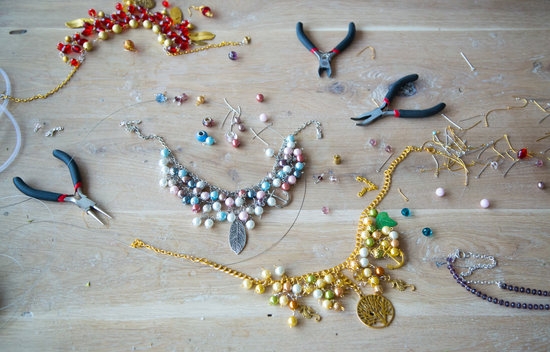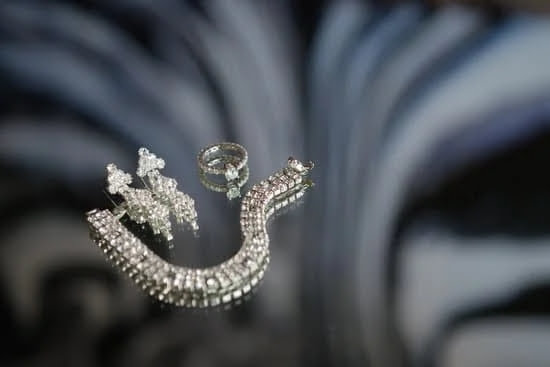What is considered handmade jewelry? Handmade jewelry refers to pieces that are crafted by hand, without the use of mass production techniques. In this article, we will explore the world of handmade jewelry, from its history to the materials and techniques used in its creation.
Handmade jewelry has a rich history that dates back to ancient civilizations, where skilled artisans crafted beautiful adornments using traditional techniques. Today, handmade jewelry continues to be highly valued for its unique and artistic qualities. From gemstones to metals and natural elements, a wide range of materials are used in the creation of handmade jewelry, each adding its own distinct beauty to the finished pieces.
In addition to discussing the materials used in handmade jewelry making, we will also explore the various techniques involved, such as wire wrapping, beading, and metal smithing. These methods require precision and skill, resulting in one-of-a-kind pieces that cannot be replicated by machines. Join us as we delve into the world of handmade jewelry and discover what sets it apart from mass-produced alternatives.
History of Handmade Jewelry
The history of handmade jewelry dates back to ancient civilization, where early humans used natural materials such as bones, shells, and stones to create adornments for themselves. These pieces were more than just decorative; they held cultural and religious significance, and were often believed to have protective or spiritual powers. As time progressed, the art of making handmade jewelry evolved, incorporating techniques and materials from different cultures around the world.
Throughout history, various civilizations have developed their own distinct styles and methods for creating handmade jewelry. From the intricate goldwork of the Byzantine Empire to the colorful beadwork of indigenous tribes in Africa and the Americas, handmade jewelry has been an important form of artistic expression for centuries. In modern times, artisans continue to draw inspiration from these ancient traditions while also incorporating contemporary designs and technology into their work.
Materials play a crucial role in the history of handmade jewelry. Gemstones such as diamonds, rubies, sapphires, and emeralds have been prized for their beauty and rarity since ancient times. Metals like gold, silver, copper, and bronze have also been used extensively in jewelry making due to their durability and malleability.
Natural elements such as pearls, shells, wood, and leather add an organic touch to handmade pieces. The use of these materials connects modern-day jewelry makers to the long-standing tradition of crafting adornments by hand.
- Early civilizations used bones, shells, and stones for handmade jewelry
- Jewelry held cultural and religious significance
- Artisans incorporate contemporary designs with ancient traditions
- Materials such as gemstones (diamonds), metals (gold), natural elements (pearls) are commonly used in handmade jewelry
Overall, the history of handmade jewelry is rich with cultural significance and artistic expression that continues to thrive today. Understanding this history allows us to appreciate the craftsmanship behind each piece and the timeless appeal of handmade jewelry.
Materials Used in Handmade Jewelry
The beauty of handmade jewelry lies in the use of high-quality materials such as gemstones, metals, and natural elements. These materials add a unique and personal touch to each piece, making them highly sought after by jewelry enthusiasts. Gemstones such as diamonds, rubies, sapphires, and emeralds are often used in handmade jewelry to add color, sparkle, and elegance. These precious stones are carefully selected and set by skilled artisans, ensuring that each piece is one-of-a-kind.
Metals like gold, silver, copper, and brass are commonly used in handmade jewelry making. Artisans often handcraft intricate designs using these metals through techniques like soldering, forging, and carving. The use of metals adds durability and versatility to the pieces, allowing for stunning designs that stand the test of time.
In addition to gemstones and metals, natural elements such as pearls, shells, wood, and leather are also incorporated into handmade jewelry. These natural materials add an organic and earthy feel to the pieces while showcasing the artisan’s creativity and connection to nature. With such a wide range of materials at their disposal, artisans can create truly diverse and captivating pieces that cater to different tastes and styles.
The use of high-quality materials is integral to what is considered handmade jewelry. Each material is carefully selected and crafted into a piece that holds both aesthetic appeal and sentimental value. Whether it’s the shimmering elegance of gemstones or the rustic charm of natural elements, these materials play a crucial role in defining the beauty and allure of handmade jewelry.
Techniques in Handmade Jewelry Making
Wire Wrapping
Wire wrapping is a technique commonly used in handmade jewelry making, where thin metal wire is manipulated into intricate designs to hold gemstones or beads in place. This method allows for creativity and innovation, as artisans can form different shapes and patterns with the wire to create unique pieces of jewelry. Whether it’s a simple pendant or an elaborate cuff bracelet, wire wrapping adds a personalized touch to each piece.
Beading
Another popular technique in handmade jewelry making is beading, which involves stringing beads onto a thread or wire to create colorful and decorative designs. Artisans use a wide variety of beads, including glass, crystal, ceramic, and metal, to craft earrings, necklaces, bracelets, and more. Beading requires precision and attention to detail, as each bead must be carefully selected and arranged to achieve a desired aesthetic.
Metal Smithing
Metal smithing is the art of shaping and manipulating metal to create jewelry pieces such as rings, earrings, and pendants. This technique involves using tools such as hammers, anvils, and torches to mold metals like gold, silver, copper, and bronze into intricate designs. Metal smiths often incorporate other techniques like soldering and etching to add texture and detail to their creations. The result is stunning handcrafted jewelry that showcases the skill and artistry of the maker.
As artisans continue to explore new materials and techniques in handmade jewelry making, the possibilities for creating one-of-a-kind pieces are endless. Each method brings its own unique flair to the finished product and contributes to the diverse world of handmade jewelry.
Qualities of Handmade Jewelry
When it comes to defining what is considered handmade jewelry, one of the key qualities to consider is its uniqueness. Handmade jewelry pieces are often one-of-a-kind, as they are crafted by artisans who infuse their own creative expression into each piece. This uniqueness makes handmade jewelry highly sought after by those seeking distinct and individualized accessories.
In addition to being unique, handmade jewelry is also known for its artistic value. Artisans who create handmade jewelry often draw inspiration from various sources, such as nature, culture, or personal experiences. As a result, each piece of handmade jewelry carries with it a certain artistic flair that sets it apart from mass-produced alternatives.
Another defining quality of handmade jewelry is its personalized nature. Many artisans offer custom-made options, allowing customers to request specific designs, materials, or details to create a piece that truly reflects their individual style and preferences. This personalized approach adds an extra layer of meaning and significance to handmade jewelry, making it a cherished item for the wearer.
The Uniqueness of Handmade Jewelry
The uniqueness of handmade jewelry lies in the fact that each piece is individually crafted by hand, rather than being mass-produced in a factory setting. This hands-on approach allows artisans to pay close attention to detail and make design choices that result in truly distinctive pieces.
The Artistic Value of Handmade Jewelry
Artistic value is inherent in handmade jewelry due to the creative process involved in its making. Artisans often incorporate artistic techniques such as sculpting, carving, or intricate metalwork to produce pieces that are not only visually appealing but also carry a deeper artistic meaning.
Personalization in Handmade Jewelry
With the option for customization and personalized touches, handmade jewelry offers customers the opportunity to own a piece that is tailored specifically to their tastes and preferences. Whether it’s incorporating birthstones, engraving initials, or designing a completely unique piece from scratch, the personalized aspect of handmade jewelry adds sentimental value for both the artisan and the customer.
The Difference Between Handmade and Mass-Produced Jewelry
One of the key distinctions between handmade and mass-produced jewelry is the level of individual attention given to each piece. Handmade jewelry is carefully crafted with attention to detail, making each item one-of-a-kind. Artisans often infuse their creations with personal expression, cultural influences, and artistic flair. Conversely, mass-produced jewelry lacks this personal touch and tends to prioritize efficiency and cost-effectiveness over authenticity and uniqueness.
Moreover, the materials used in handmade jewelry are often chosen for their quality and individual character. Artisans may incorporate gemstones, metals, and natural elements into their designs, selecting each material for its specific properties and aesthetic appeal. In contrast, mass-produced jewelry typically relies on cost-effective materials that can be easily replicated to produce identical pieces at scale.
In summary, what is considered handmade jewelry distinguishes itself from mass-produced jewelry through its personalized craftsmanship, attention to detail, and use of quality materials. These differences contribute to the unique appeal of handmade jewelry for those seeking individuality and artistic expression in their accessories.
| Handmade Jewelry | Mass-Produced Jewelry |
|---|---|
| Crafted by skilled artisans | Manufactured using machinery |
| Individual attention to each piece | Lack of personal touch |
| Quality materials with individual character | Cost-effective materials for replication |
The Cultural Significance of Handmade Jewelry Around the World
In many indigenous cultures, handmade jewelry is crafted using traditional techniques that have been passed down through generations. These pieces often incorporate materials endemic to the region, such as feathers, shells, and natural stones, and are adorned with symbols representing elements of nature or spiritual beliefs. For example, in Native American culture, handcrafted silver jewelry featuring intricate patterns and turquoise holds deep spiritual significance and is worn as a means of protection and connection to the earth.
Furthermore, in many parts of Asia, particularly in countries like India and Nepal, handmade jewelry is deeply intertwined with religious and ceremonial practices. Pieces are often created by skilled artisans using traditional methods such as filigree work or enameling.
These adornments are worn during special occasions like weddings or religious festivals and are believed to bring blessings and prosperity to the wearer. The intricate designs tell stories of deities, folklore, and ancient traditions that have been preserved through the art of jewelry making.
| Cultural Significance | Examples |
|---|---|
| Deep spiritual significance | Native American silver jewelry |
| Religious and ceremonial practices | Jewelry from India and Nepal |
How to Identify Authentic Handmade Jewelry
When it comes to purchasing handmade jewelry, it’s important to be able to identify authentic pieces from mass-produced ones. Here are some tips on how to spot the real deal:
- Look for imperfections: Handmade jewelry is often not perfectly symmetrical or uniform. Small imperfections or irregularities in the design can indicate that the piece was crafted by hand.
- Check for artist signatures or marks: Many artisans will leave their mark on their creations, either with a signature, stamp, or other identifying mark. This can add to the value and authenticity of the piece.
- Examine the materials and craftsmanship: Authentic handmade jewelry is typically made with high-quality materials and meticulous craftsmanship. Take a close look at the details and overall quality of the piece.
It’s also helpful to research the artisan or designer behind the jewelry. Many makers of authentic handmade jewelry have their own stories, techniques, and values that they bring into their craft. Purchasing directly from these artisans, whether through local markets, craft shows, or online platforms, can ensure that you are getting a truly unique and genuine piece.
Ultimately, what is considered handmade jewelry goes beyond just its creation process; it encompasses the passion, creativity, and individuality of the artisan. By learning to identify authentic handmade pieces, you can appreciate and support the artistry behind each unique creation.
Conclusion
In conclusion, handmade jewelry holds a timeless appeal that transcends generations and cultural boundaries. As we have explored in this article, the history of handmade jewelry dates back to ancient times and continues to evolve with modern techniques and materials. The use of gemstones, metals, and natural elements, along with various techniques such as wire wrapping, beading, and metal smithing, contribute to the unique and artistic qualities of handmade jewelry.
What is considered handmade jewelry goes beyond just being crafted by hand; it embodies the passion, creativity, and personal touch of the artisan. This personalized aspect is what sets handmade jewelry apart from mass-produced pieces, making each item a work of art with its own story to tell. The cultural significance of handmade jewelry around the world further adds to its allure, as it represents tradition, heritage, and craftsmanship.
In today’s market flooded with mass-produced items, identifying authentic handmade jewelry can be a challenge. However, with a discerning eye for quality and craftsmanship, consumers can appreciate the value of genuine handmade pieces. As we continue to celebrate the beauty and uniqueness of handmade jewelry, it serves as a reminder of human creativity and the enduring appeal of artisanal craftsmanship.
Frequently Asked Questions
How Can You Tell if Jewelry Is Handmade?
You can tell if jewelry is handmade by closely examining the craftsmanship and intricate details. Handmade jewelry often shows unique imperfections, irregular shapes, and personalized touches that set it apart from mass-produced pieces.
What Is the Difference Between Handcrafted and Handmade Jewelry?
The main difference between handcrafted and handmade jewelry lies in the level of involvement of the artist. Handcrafted jewelry may involve the use of tools or machinery, while handmade jewelry is crafted purely by hand without any aid from machines or tools.
What Is the Legal Definition of Hand Made?
The legal definition of “handmade” can vary depending on the country or region. In general, it refers to products that are made predominantly by hand with minimal use of machinery. However, specific laws and regulations may differ, so it’s important to check local guidelines for clarity.

Welcome to my jewelry blog! My name is Sarah and I am the owner of this blog.
I love making jewelry and sharing my creations with others.
So whether you’re someone who loves wearing jewelry yourself or simply enjoys learning about it, be sure to check out my blog for insightful posts on everything related to this exciting topic!





